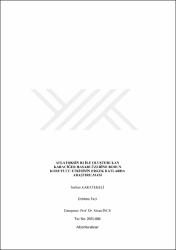Aflatoksin B1 ile oluşturulan karaciğer hasarı üzerine borun koruyucu etkisinin erkek ratlarda araştırılması
Abstract
Mikotoksinler içerisinde önemli yeri olan aflatoksinlerin gıda ve yem kaynaklı
bulaşmaları insan ve hayvan sağlığı üzerinde ciddi sağlık problemlerini beraberinde
getirmektedir. Bunların alınması sonucu karaciğer başta olmak üzere doku ve
organlarda özel zehirli etkiler (kanserojen, teratojen ve mutajenik etkiler) ile
hepatotoksik, nefrotoksik, genotoksik ve immünosüpresif etkiler ortaya çıkmaktadır.
Bu nedenle aflatoksinlerden kaynaklı istenmeyen zararların önüne geçilmesinde
antioksidan özellik gösteren çeşitli maddeler öncelikle tercih edilmektedir. Bor ve
bileşiklerinin antioksidan, hücre koruyucu, antigenotoksik etkilerinin olduğu
bildirilmiştir. Yapılan bu tez çalışmasında subakut Aflatoksin B1 (AFB1) ile
karaciğer hasarı oluşturulan ratlarda borun koruyucu etkisinin araştırılması
amaçlandı. Çalışmada erkek Sprague Dawley cinsi ratlara AFB1 0,125 mg/kg ve
borik asit 5, 10 ve 20 mgBor/kg dozları 21 gün süresince verildi. AFB1
uygulamasının karaciğer enzim aktiviteleri (AST, ALT ve ALP) ve lipid
peroksidasyon (MDA) düzeylerini artırdığı, diğer taraftan glutatyon (GSH) ve
antioksidan enzim aktivitelerinde (SOD ve CAT) ise azalma meydana getirdiği
belirlendi. Ayrıca, karaciğer dokusunda apoptotik (Bax, Caspase 3, Caspase 8,
Caspase 9 ve p53) ve proinflamatuvar (TNF-α ve NFκB) genlerin mRNA ekspresyon
düzeylerinin arttığı ve antiapoptotik gen olan Bcl-2’nin mRNA ekspresyonun
azaldığı tespit edildi. AFB1 uygulamasının DNA hasarını artırdığı ve karaciğer
dokusunda ise histopatolojik değişiklikler oluşturduğu gözlendi. AFB1 ile birlikte
verilen 5, 10 ve 20 mg/kg dozda bor uygulamalarının ise oluşan bu olumsuz
değişikleri tersine çevirdiği tespit edildi. Sonuçta borun AFB1 ile indüklenen
karaciğer hasarına karşı antioksidan, antiinflamatuvar ve antiapoptotik etkisi ile
birlikte hepatoprotektif etki sergilediği belirlendi. Contamination of aflatoxins, which has an important place among mycotoxins, from
food and feed brings serious health problems on human and animal health. Because
of their intake, special toxic effects (carcinogenic, teratogenic, and mutagenic
effects) and hepatotoxic, nephrotoxic, genotoxic, and immunosuppressive effects
occur in tissues and organs, especially in the liver. For this reason, various
substances with antioxidant properties are primarily preferred to prevent undesirable
damage caused by aflatoxins. It has been reported that boron and its compounds have
antioxidant, cell protective, and antigenotoxic effects. In this thesis, it was aimed to
investigate the protective effect of boron in rats with subacute Aflatoxin B1 (AFB1)
liver damage. In the study, 0,125 mg/kg AFB1 and 5, 10, and 20 mg Boron/kg doses
of boric acid were given to male Sprague Dawley rats for 21 days. It was determined
that AFB1 tretament increased liver enzyme activities (AST, ALT, and ALP) and
lipid peroxidation (MDA) levels, on the other hand, it caused a decrease in
glutathione (GSH) and antioxidant enzyme activities (SOD and CAT). In addition, it
was determined that the mRNA expression levels of apoptotic (Bax, Caspase 3,
Caspase 8, Caspase 9, and p53) and proinflammatory (TNF-α and NFκB) genes in
liver tissue increased and the mRNA expression of the antiapoptotic gene (Bcl-2)
decreased. It was observed that AFB1 tretament increased DNA damage and caused
histopathological changes in the liver tissue. It was determined that boron
applications at doses of 5, 10, and 20 mg/kg given with AFB1 reversed these
negative changes. As a result, it was determined that boron exhibited
hepatoprotective effect together with antioxidant, anti-inflammatory, and
antiapoptotic effects against AFB1-induced liver damage.
Collections
- Doktora Tezleri [154]



















